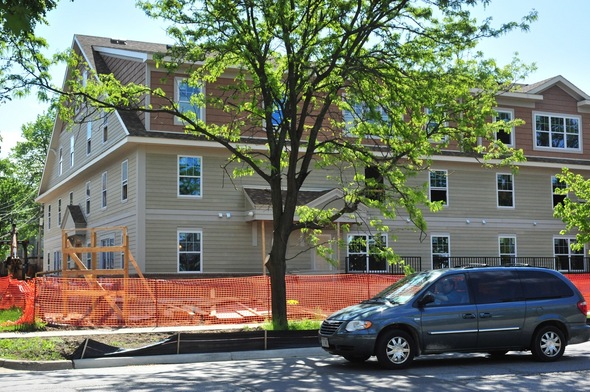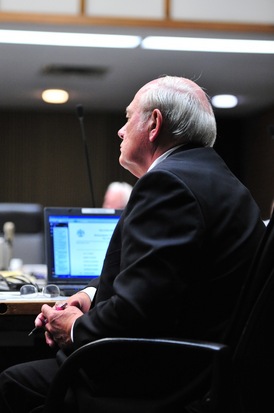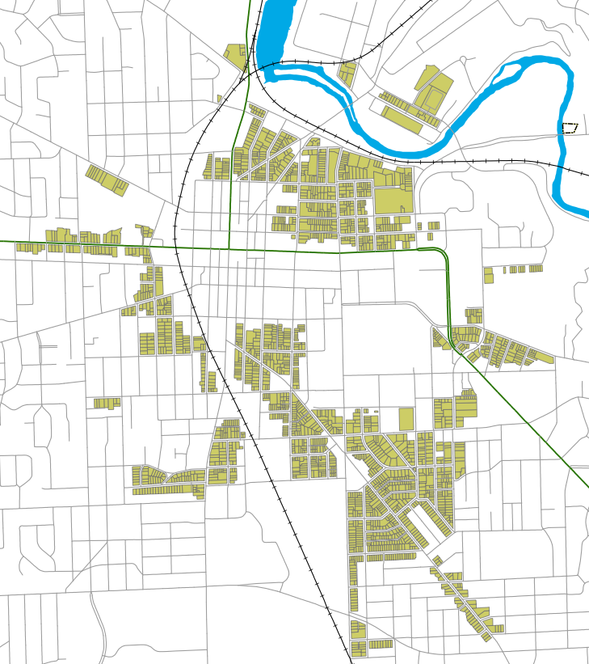Zoning changes could stop future 'mega projects' in Ann Arbor neighborhoods

Ann Arbor's proposed zoning changes would stop future projects like City Place, a 24-unit, 144-bedroom student apartment complex taking shape here on Fifth Avenue just south of downtown. In order to pave the way for City Place, the developer combined several properties to achieve a 53,579-square-foot lot area and demolished seven century-old homes that stood in the way.
Ryan J. Stanton | AnnArbor.com
A report three years in the making has been released by the city's R4C/R2A Zoning District Study Advisory Committee and it recommends a series of zoning changes.
Most notably, the report recommends a limit on lot combinations within the city's R4C zoning district, a multiple-family dwelling district that surrounds downtown.
The report contemplates restricting the maximum size of a combined lot in the R4C district to 6,525 square feet, which is the area needed to permit three housing units.
City Planner Matt Kowalski said in the future that would stop projects similar to the controversial City Place, a 24-unit, 144-bedroom student apartment complex taking shape on Fifth Avenue.

City Planner Matt Kowalski
Ryan J. Stanton | AnnArbor.com
"With the limitation on the lot combinations, once that went in place, that would absolutely stop any project whether it's City Place or even a smaller 10,000-square-foot building," Kowalski said. "Without the ability to combine the lots and the maximum of 6,525 square feet, which is what we're recommending, that would pretty much eliminate any possibility of that."
City Place, because it conformed with the city's existing zoning ordinances, was considered a "by-right" project, and so city officials — even though they didn't like the project, and even though neighbors furiously protested it — felt they couldn't stop it.
The project, approved by the City Council almost three years ago, was the impetus for the formation of the R4C/R2A study committee in 2009. City Place is now nearing completion and is expected to welcome University of Michigan students as tenants by this fall.
The council appointed members to the advisory committee in September 2009, but it didn't hold its first meeting until December 2009.
The committee struggled at times to reach consensus and has been criticized for not coming back with recommendations sooner. But during a Planning Commission working session Tuesday night, the 16-page report presented by Kowalski was praised.
"This seems like a great report," said Planning Commissioner Erica Briggs. "It's exciting to look at this and see how much work has gone into it and how much consensus there really seems to be. It was such a huge, controversial project, and really, I mean, it's a few years later, but I think there are some really solid recommendations here."
Kowalski, who authored the report based on the committee's findings, acknowledged it was a longer process than some would have liked.
"But I give the committee a lot of credit," he said. "It's not a simple thing. I think R4C is one of the most complicated and diverse districts that we have out there."
The report is now in the Planning Commission's hands and there's interest in getting some of the recommended zoning ordinance changes to the City Council for approval soon.
"I would like to think we could expedite things and get some ordinance language drafted," said Planning Commissioner Kirk Westphal.
Maureen Sloan, CEO of the Builders and Remodelers Association of Greater Ann Arbor, said her group has no strong position either way on the proposed zoning changes.
"Of course, we believe in private property rights, so if someone owns private property, we don't want it too restricted," she said. "But most of our members are not building new developments in the city right now. We have a lot of remodeling going on."
Jeff Helminski, the developer behind City Place, could not be reached to comment. Helminski also was the developer behind The Moravian, another controversial student apartment proposal near downtown that was voted down by the City Council in April 2010.
In addition to lot combinations, the report recommends a number of other zoning changes, including some that remove incentives for developers to build five- and six-bedroom apartment units. The City Place project features almost entirely six-bedroom units.
Kowalski said there's been a shift toward six-bedroom rental units throughout R4C, which includes properties around downtown and in student rental areas off Packard Street.
"Even the former single-family houses and things like that, they're all going to six-bedroom units," he said.
"It's not like we're limiting five- and six-bedrooms — we're just raising the lot area required for them," Kowalski added. "So you can still do them, you just need more lot area."
Council Member and Planning Commissioner Tony Derezinski, D-2nd Ward, sponsored the resolution in early 2009 that directed the Planning Commission and staff to work with the public to provide council with a report on potential zoning changes in the Central Area.

Council Member and Planning Commissioner Tony Derezinski, D-2nd Ward, sponsored the resolution in early 2009 that directed the Planning Commission and staff to work with the public to provide council with a report on potential zoning changes in the Central Area.
Ryan J. Stanton | AnnArbor.com
The city's R4C (multiple-family dwelling) and R2A (two-family dwelling) zoning districts were established in 1963.
Although the original charge was to take a look at both R4C and R2A, Kowalski said, it was discovered that a lot of the issues of concern aren't necessarily in the R2A neighborhoods. And so the report focuses almost exclusively on fixes to the city's R4C zoning.
"R4C really is a broken district," said Planning Manager Wendy Rampson.
Kowalski acknowledged there are a lot of other issues within the R4C neighborhoods that the report doesn't address because the committee didn't have the time or because it wasn't the mission. He mentioned concerns about trash and noise from student parties.
The Planning Commission heard from Ethel Potts and Wendy Carman, two of the 12 members of the advisory committee, during Tuesday's working session.
Carman said the existing zoning imposed on R4C neighborhoods unfortunately made it so property owners and developers had to combine lots in order to build something new, and that meant tearing down or changing the character of the neighborhood.
"The committee and the community were absolutely unanimous in trying to preserve the character, the streetscape of what's there," she said. "We wanted to reduce the incentive for six-bedroom apartments because they're really only usable for students."
The advisory committee recommends no changes be made to the setbacks or required open space for the R4C district. It believes maintaining existing setback requirements will help reduce the scale of new construction and additions by maintaining open space and preventing larger additions closer to the property line on some existing non-conforming structures.
"At some point, the report is what it is," Potts said. "I think it would not be hard for you to go directly from the report to ordinance revisions."

Parcels zoned R4C in the city of Ann Arbor. (Download larger PDF version.)
Courtesy of city of Ann Arbor
Ryan J. Stanton covers government and politics for AnnArbor.com. Reach him at ryanstanton@annarbor.com or 734-623-2529. You also can follow him on Twitter or subscribe to AnnArbor.com's email newsletters.


Comments
Irwin Daniels
Thu, May 10, 2012 : 6 p.m.
How many people who are commenting about the former house on Fifth Ave. saw the "insides" of these houses? I did, in fact I lived in one - no offence to the previous owners but they were total dumps, and unsafe. If you want to call those houses "historical" the year built was old but (the house I lived at) was a total chop job - insides were crappy in latter day 60's no real historical value except for when it was built. G.
Basic Bob
Fri, May 11, 2012 : 10:28 a.m.
Clearly they were prime for redevelopment because they could be bought cheaply. Had they been 19th century gems some people believe, the cost to develop student housing on this property would have been prohibitive.
Bonsai
Thu, May 10, 2012 : 7:26 p.m.
one can probably say the same thing about many of the single-family homes this new zoning plan is meant to protect -- we say they add to the "character" of the city, but they're really just cash cows for landlords who invest as little as possible in them -- if we want to protect the city's character, we should demand better from the landlords -- keep up the inside and outside of your properties for crying out loud!
JRW
Thu, May 10, 2012 : 5:50 p.m.
So this ugly City Place project adds 144 bedrooms to 5th Ave. Where are all these cars going to park? As if downtown congestion isn't bad enough. If you think the UM students leave their cars at home, think again.
Bonsai
Thu, May 10, 2012 : 7:21 p.m.
I dunno.... how about that new parking structure down the street?
JRW
Thu, May 10, 2012 : 5:40 p.m.
WAAAAY tooo long to get this report done. The damage has been done in A2 with the monster student housing projects already built and being built that benefit developers at the expense of neighborhoods. Too late. Developers cruise into town, demolish the historical landscape to suit their needs, rake in profits and leave town. A2 allowed this to happen and after the fact, comes up with a report 3 years in the making? Ugh.
Arboriginal
Thu, May 10, 2012 : 4:37 p.m.
Please do not forget that City Place was built because the nincompoops would not allow an alternative that included saving the facades of the houses. Isn't that what "Historic Preservation" is all about? Saving the shallow facade of a structure, with no concern about it being divided into a multitude of lousy apartments?
Psudolus
Thu, May 10, 2012 : 3:37 p.m.
Who cares what happens on 5th Ave., I haven't seen it for years because it has been closed due to construction.
brimble
Thu, May 10, 2012 : 2:10 p.m.
There seems to be a disjuncture between this report and other statements and/or zoning decisions from Council. Why is there not a comprehensive, City-wide planning and zoning plan? Why is this -- admittedly unattractive -- high-density, multi-unit housing not appropriate close to downtown, but apparently okay on South Maple, where occupants will have to commute via cars or buses to campus? Why is the R4C designation granted on a parcel-by-parcel basis? Why not comprehensive planning that includes consideration for infrastructure, traffic, and environmental factors? Why not have a real conversation about balancing the demands of student housing, traditional residential, and commercial use? A little leadership is called for here...
Sabra C Briere
Thu, May 10, 2012 : 3:13 p.m.
There are a number of comprehensive, city-wide master plans. These plans agree, and are updated regularly. These master plans consider natural features, traffic, infrastructure, etc. There's also a comprehensive city-wide zoning plan. The R4C/R2A committee was tasked with updating it, as it is essentially from the 1960s. All zoning is by both area and parcel, because parcels are in areas.
mixmaster
Thu, May 10, 2012 : 2 p.m.
The primary concerns of planning and development should be sustainability and the scale of structures in relation to their surroundings, not how many tax dollars a site could garner.
mixmaster
Thu, May 10, 2012 : 5:10 p.m.
It seems that some of us haven't learned anything from the last 20 years. As well as the economy, development must do everything it can to avoid booms and busts. From the economy to local development, Go-Go growth is unsustainable. Who determines what objective is and how to measure it? We're dealing with people here. Subjectivity cannot be avoided. Livability is a primary concern. People don't want to live in warehouses. Massive, out of scale housing is proven to be not "livable" and thus will not be sustainable.
Brad
Thu, May 10, 2012 : 2:08 p.m.
How about instead of "sustainability" we use *objective* measures? And no, "livability" isn't one, either.
DeeDee
Thu, May 10, 2012 : 1:36 p.m.
Taking a look at the map, it certainly appears that a huge number of primarily single family neighborhoods in the Burns Park area for example, are potential locations for developments of this nature. It definitely seems that there should be restrictions in at least some of these areas with regard to the type of development allowed. Locations just across from Burns Park seem to be zoned the same as those right at State and Packard for example. This makes no sense, and some reasonable changes appear to be appropriate.
Basic Bob
Fri, May 11, 2012 : 10:24 a.m.
I don't read the map that way. There is no R4C within a block of Burns Park; there is none within two blocks except those on Packard.
clownfish
Thu, May 10, 2012 : 12:49 p.m.
How dare citizens work with their government in attempts to keep their community the way they like it! How UN-American can one place be! Do you see the N. Koreans limiting building? The Chinese? No way, those folks know how to run a country.
Linda Peck
Thu, May 10, 2012 : 12:44 p.m.
I like this direction. Huge apartment complexes in these old neighborhoods just don't work. They cast a huge shadow on the existing homes. Downtown is a different situation, but neighborhoods are supposed to be somewhat homey, and that means respecting the homes that are already there.
Stephen
Thu, May 10, 2012 : 12:36 p.m.
What an ugly building
Larry Baird
Thu, May 10, 2012 : 12:24 p.m.
So the pendulum swings from the huge City Place example to allowing only three housing units for combined lots? That seems a bit extreme. How about finding a middle ground, the new five unit townhouse development on Catherine announced yesterday would not even qualify under these new rules.
Veracity
Thu, May 10, 2012 : 12:20 p.m.
Does no one else believe that City Place is unattractive and that the houses destroyed by its construction were quaint historic markers that added character to the neighborhood? Ann Arbor has had a vibrant culture since its inception 187 years ago which spawned interesting buildings downtown and in our outlying neighborhoods which are all worth preserving. Have you ever spent time reading the historic markers dotting downtown that describe the chronological use of the remaining historic buildings?
john
Thu, May 10, 2012 : 1 p.m.
Alex DePerry had a sound plan to preserve these houses, The Nimbys around Germantown and our great city government felt no need to compromise. How you view now Tom?
Chris
Thu, May 10, 2012 : 12:42 p.m.
..which only the rich can enjoy, because no one is building housing and rents are way too high.
laura wolf
Thu, May 10, 2012 : 12:41 p.m.
city place is just boring, but you don't get an exciting, varied and interesting city by adding restrictions and rules . you can't legislate beauty and cuteness and whatever else you feel the city should look like. freedom is messy but along with ugly and boring you get creative, wonderful and new greatness that no one else come up with yet. i am willing to live with ugly and run down to get wonder, excitement and beauty.
Brad
Thu, May 10, 2012 : 12:41 p.m.
Feel free to start buying them up and preserving them at any time.
Brad
Thu, May 10, 2012 : noon
Do you want your "density" or not? Make up your minds, will you?
Tom Whitaker
Thu, May 10, 2012 : 4:06 p.m.
The City spent over five years crafting a new downtown plan and zoning that allows for very high residential density, mixed use, and "active streets" in the core D1 district and to a lesser extent, the core fringe, D2 areas. The R4C areas, as seen on the map in the article, are outside this high density, downtown core. They provide an alternative to high rises that are attractive to families, retirees, students, and others. If your point is that urban density is needed to counteract suburban sprawl, I would argue that those attracted to sprawl developments are not interested in small, expensive, high-rise housing, but instead are looking for places that provide much of what they like about suburbia--single-family houses with garages and a yard. Further, if you allow dense developments everywhere in the city, there is no incentive to build larger, taller buildings in the core, where municipal services are most cheaply and efficiently provided.
pbehjatnia
Thu, May 10, 2012 : 11:52 a.m.
I say we should go back to horse and buggy and place anti-modernist restrictions on all buildings present, past and future. If the structure does not meet an unqualified opinion of victoriana then it should be demolished, denied permits. This will ensure the future economic security of our residents. Yes. This is the way to go. All structures from chicken coops to badly built housing at least a century old should be preserved and the neighborhoods they are in should be gated tax free zones requiring period correct dress and social interactions. We should also take the vote from women and reinstate indentured servitude and the use of wives and children as chattel in these zones. That would definitely preserve the charm of Ann Arbor.
thecompound
Thu, May 10, 2012 : 1:06 p.m.
Maybe if you went that far back, that fence could have stayed, lol
Bcar
Thu, May 10, 2012 : 11:39 a.m.
3 years?? THREE years?? Wow, if that alone doesnt tell us something about our city gov't I dont know what else would... I agree with it though, Im not a fan of these big box housing projects, but thats just my opn...
John Alan
Thu, May 10, 2012 : 11:36 a.m.
Please read the meeting minutes that R4C/R2A had during last three years...... very un-organized group of appointed members with a pre-set agenda of wanting students out of their backyard. Once you read the meeting minutes, whole thing sounds like joke. Pure waste of time and tax money.
Veracity
Thu, May 10, 2012 : 12:06 p.m.
Please read my reply to "M's" comment above.
M
Thu, May 10, 2012 : 11:17 a.m.
I wish those in charge would stop telling us what's best for us. If we can't build out because of the greenbelt, we can't build up because of ordinances, and now we can't combine several lots... for what reason? So that people have to spend an arm and a leg to rent anywhere in the city. This is another lame attempt at making Ann Arbor elite. Knock the horsepoop off and let the city thrive.
dotdash
Thu, May 10, 2012 : 12:18 p.m.
There are lots of other places whose main goal is maintaining cheap rents. Ann Arbor, apparently, strives for something a bit more. Good for us.
Veracity
Thu, May 10, 2012 : 12:04 p.m.
M, So you see no unique characteristics in the downtown area that are worth maintaining? You would prefer a tear-down-and-build-bigger design that will produce a hodgepodge of unattractive and discordant structures to define our downtown?
Craig Lounsbury
Thu, May 10, 2012 : 10:58 a.m.
so if I get this straight.... we need to stop urban sprawl that's "bad". we need to stop buildings from being too tall that's "bad too" we need to stop single family structures from becoming multifamily structures I guess we need to freeze the city right here...its perfect....except for a couple more fancy restaurants with twinkling lights along the river on the north side.
Myles
Thu, May 31, 2012 : 12:36 a.m.
Im also from Ypsilanti I just moved to Ann arbor this year even though I wanted to move to Dearborn Heights...but any way I just want to know why do a lot of Ann arbor people are so against these developments? I think this development is beneficial but there should be SOME limitations. I see all of these restrictions as road blocks preventing Ann arbor to become a striving major city. In Ypsilanti there is no development and for citizens of a2 to be against the two high rise apartments is unnecessary.
JRW
Thu, May 10, 2012 : 5:47 p.m.
No one is talking about "freezing" the city at any point in time. Change will happen. But if monster student housing project steam roll over neighborhoods, and out of scale "development" continues only to generate tax dollars for the city, no one wins except the greedy developers who have no regard for the damage their project inflict on residential neighborhoods and downtown areas. Development can happen in a proportional and responsible manner, but that is not the case in A2.
Mike
Thu, May 10, 2012 : 1:21 p.m.
Don't forget affordable housing that these same opponents will spout off about as long as it's not in their neighborhood.
Craig Lounsbury
Thu, May 10, 2012 : 12:44 p.m.
"Without this restriction eventually all the wonderful small city character that defines Ann Arbor would be lost." I moved to Ann Arbor from Ypsilanti in 1984. I have no clue what your idea of " wonderful small city character" is but i can say the city today is very different than the city of 1984 which was different from the city of 1954 which was different from..... So change happens.
Veracity
Thu, May 10, 2012 : 11:57 a.m.
Yes. But, as the article points out, it comes too late to prevent City Place. Without this restriction eventually all the wonderful small city character that defines Ann Arbor would be lost.